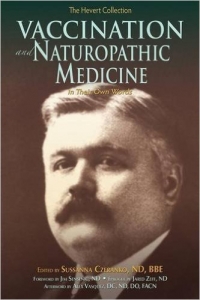Naturopathic primary care group endorses CDC’s immunization schedule
December 29, 2016
by John Weeks, Publisher/Editor of The Integrator Blog News and Reports
 The final 2016 edition of the Communicable Disease Epidemiology and Immunization Quarterly concludes with a two-page article, “NAPCP Approves Position Paper on Immunizations.” The focus is the August 2016 statement from the Naturopathic Academy of Primary Care Physicians (NAPCP). The position, which is “in support of the Centers for Disease Control and Prevention (CDC) Advisory Committee on Immunization Practices (ACIP) childhood immunization schedule,” was reportedly “overwhelmingly supported” by the specialty society’s members. The NAPCP chose to publish key points of the position paper after it passed. The first is the NAPCP “takes a clear pro-immunization position.” While members recognized that “there may be differences of opinion and dissent in both naturopathic and conventional medical communities,” the statement urges naturopathic physicians to “recommend, provide, or refer for appropriate immunizations according to CDC’s childhood immunization or catch-up schedules.” In support of this approach, NDs “should provide a copy of the official CDC immunization schedule and standard written informed consent for the patient or parent to sign, stating they understand the risks if there is variance from the CDC’s immunization schedule.”
The final 2016 edition of the Communicable Disease Epidemiology and Immunization Quarterly concludes with a two-page article, “NAPCP Approves Position Paper on Immunizations.” The focus is the August 2016 statement from the Naturopathic Academy of Primary Care Physicians (NAPCP). The position, which is “in support of the Centers for Disease Control and Prevention (CDC) Advisory Committee on Immunization Practices (ACIP) childhood immunization schedule,” was reportedly “overwhelmingly supported” by the specialty society’s members. The NAPCP chose to publish key points of the position paper after it passed. The first is the NAPCP “takes a clear pro-immunization position.” While members recognized that “there may be differences of opinion and dissent in both naturopathic and conventional medical communities,” the statement urges naturopathic physicians to “recommend, provide, or refer for appropriate immunizations according to CDC’s childhood immunization or catch-up schedules.” In support of this approach, NDs “should provide a copy of the official CDC immunization schedule and standard written informed consent for the patient or parent to sign, stating they understand the risks if there is variance from the CDC’s immunization schedule.”  The Quarterly’s article is an interview with Jonathan Bell, ND, pictured, a co-author of the NAPCP paper. Bell is a past member of Washington State Department of Health’s Vaccine Advisory Committee. He explained that the Academy took the step because the profession’s national professional association, the American Association of Naturopathic Physicians (AANP), “failed to come up with a consensus opinion” to update the organization’s 1991 paper. That paper was “too ambivalent about advocacy for vaccines, questions the safety of vaccines, and undervalues the benefits of immunization,” said Bell. Bell notes that, while recognizing the AANP’s role as the licensed profession’s national organization, the AANP “doesn’t, however, represent the voice of all AANP specialty groups.” He sees his role as “trying to evolve naturopathic medicine to reflect the most modern scientific advances.” Immunization is a “natural” process, and congruent with the naturopathic philosophical concepts of “Prevention”, “Treat the Cause”, and “Wellness,” says Bell. The NAPCP’s goal with the position paper is to “give guidance to ND [primary care providers] and alternative health providers who respect scientific research and understand the need for evidence-based guidelines.” The Quarterly asked Bell whether he feels the paper represents “a watershed moment” for the naturopathic profession. Bell speaks of the action as a key “evolutionary step,” especially given what he views as its emerging role “to reach those who fear immunization and to set an example for other alternative health providers.” As alternative medicine experts, says Bell, naturopathic doctors have “a unique opportunity to reach alternative medicine seeking communities with this powerful tool.” Bell acknowledges that although he recognizes the practice is not recommended by ACIP, he will “spread out the vaccine schedule if needed to gain trust and ultimately to get my patients and community vaccinated,” he says. “I envision that the naturopathic profession will continue to grow to be a force in vaccine advocacy, because vaccines are consistent with naturopathic medicine and most importantly, because they are effective in increasing the health of individuals and their communities,” says Bell.
The Quarterly’s article is an interview with Jonathan Bell, ND, pictured, a co-author of the NAPCP paper. Bell is a past member of Washington State Department of Health’s Vaccine Advisory Committee. He explained that the Academy took the step because the profession’s national professional association, the American Association of Naturopathic Physicians (AANP), “failed to come up with a consensus opinion” to update the organization’s 1991 paper. That paper was “too ambivalent about advocacy for vaccines, questions the safety of vaccines, and undervalues the benefits of immunization,” said Bell. Bell notes that, while recognizing the AANP’s role as the licensed profession’s national organization, the AANP “doesn’t, however, represent the voice of all AANP specialty groups.” He sees his role as “trying to evolve naturopathic medicine to reflect the most modern scientific advances.” Immunization is a “natural” process, and congruent with the naturopathic philosophical concepts of “Prevention”, “Treat the Cause”, and “Wellness,” says Bell. The NAPCP’s goal with the position paper is to “give guidance to ND [primary care providers] and alternative health providers who respect scientific research and understand the need for evidence-based guidelines.” The Quarterly asked Bell whether he feels the paper represents “a watershed moment” for the naturopathic profession. Bell speaks of the action as a key “evolutionary step,” especially given what he views as its emerging role “to reach those who fear immunization and to set an example for other alternative health providers.” As alternative medicine experts, says Bell, naturopathic doctors have “a unique opportunity to reach alternative medicine seeking communities with this powerful tool.” Bell acknowledges that although he recognizes the practice is not recommended by ACIP, he will “spread out the vaccine schedule if needed to gain trust and ultimately to get my patients and community vaccinated,” he says. “I envision that the naturopathic profession will continue to grow to be a force in vaccine advocacy, because vaccines are consistent with naturopathic medicine and most importantly, because they are effective in increasing the health of individuals and their communities,” says Bell.  Comment: The vaccination debates in the naturopathic profession have moved, in the unfolding way of healing, from inside and hidden to the surface. More graduates are participating in regular medicine as PCPs. The field’s leaders, including NAPCP co-founder Bruce Milliman, ND, produced a white paper on how naturopathic doctors can help meet the nation’s primary care needs. In a talk at the 2014 Integrative Healthcare Symposium, Bill Walter, ND, who was hired by a County Health Department in Oregon to works in a Coordinated Care Organization, told the audience that any challenge to the schedule is essentially a non-starter. NAPCP has now drawn a line in the sand. Time will tell what the AANP, as the field’s umbrella organization will, or won’t, choose to do with this hot topic. My guess is that differing perspectives on Bell’s assertion that the action of immunizations is fully aligned with naturopathic principles is part of what has kept the AANP from updating its 1991 position. The origins of the division are made clear in Vaccination and Naturopathic Medicine, a recent volume of historic records edited by Sussanna Czerenko, ND, BBE. The series of articles, letters-to-the-editor, and essays from the 1890-1930 periods are a compelling re-connection to the origins of the debate. The present flurry of immunization activity was just getting its very first wings—or, more precisely, its injections of infected bovine teat to vaccinate against small pox. The reader is forced to recall that the principle clinical tools employed by the medical doctors who pioneered immunization were mercury, arsenic, and blood-letting. This does not dispose one to give the progenitors the benefit of any doubt. Given the naturopathic doctors’ advocacy 100 years ago for public health measures such as clean water, functioning sewage systems, and other social investment in place of immunizations, it is easy to be sympathetic to the revulsion of immunization’s antagonists to greeting newborns with injections of purulent matter. One value in the NAPCP position paper is to more strongly align the naturopathic doctors with these public health perspectives for which, a century ago, they were among the most fierce advocates.
Comment: The vaccination debates in the naturopathic profession have moved, in the unfolding way of healing, from inside and hidden to the surface. More graduates are participating in regular medicine as PCPs. The field’s leaders, including NAPCP co-founder Bruce Milliman, ND, produced a white paper on how naturopathic doctors can help meet the nation’s primary care needs. In a talk at the 2014 Integrative Healthcare Symposium, Bill Walter, ND, who was hired by a County Health Department in Oregon to works in a Coordinated Care Organization, told the audience that any challenge to the schedule is essentially a non-starter. NAPCP has now drawn a line in the sand. Time will tell what the AANP, as the field’s umbrella organization will, or won’t, choose to do with this hot topic. My guess is that differing perspectives on Bell’s assertion that the action of immunizations is fully aligned with naturopathic principles is part of what has kept the AANP from updating its 1991 position. The origins of the division are made clear in Vaccination and Naturopathic Medicine, a recent volume of historic records edited by Sussanna Czerenko, ND, BBE. The series of articles, letters-to-the-editor, and essays from the 1890-1930 periods are a compelling re-connection to the origins of the debate. The present flurry of immunization activity was just getting its very first wings—or, more precisely, its injections of infected bovine teat to vaccinate against small pox. The reader is forced to recall that the principle clinical tools employed by the medical doctors who pioneered immunization were mercury, arsenic, and blood-letting. This does not dispose one to give the progenitors the benefit of any doubt. Given the naturopathic doctors’ advocacy 100 years ago for public health measures such as clean water, functioning sewage systems, and other social investment in place of immunizations, it is easy to be sympathetic to the revulsion of immunization’s antagonists to greeting newborns with injections of purulent matter. One value in the NAPCP position paper is to more strongly align the naturopathic doctors with these public health perspectives for which, a century ago, they were among the most fierce advocates.



















SHARE